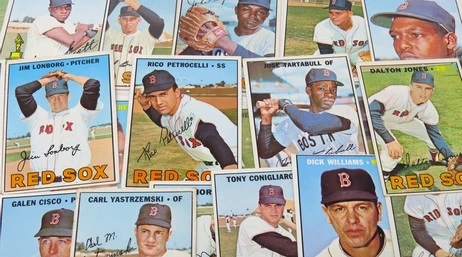Baseball cards have always been a cherished aspect of American culture, transcending generations and economic cycles. However, their role has evolved from simple collectibles to lucrative investment assets. As of 2024, the baseball card market has seen significant shifts, with some cards fetching astonishing prices. This article delves into the baseball cards currently worth the most money, highlighting trends, key players, and what drives their value.
The Evolution of Baseball Card Values
The value of baseball cards has fluctuated over time, largely influenced by the era in which they were produced. Broadly, cards can be categorized into four groups: Pre-War Vintage (pre-1945), Vintage (1946-1983), Modern (1984-2008), and Ultra-Modern (2009-present). Each category has experienced different levels of appreciation.
- Pre-War Vintage: Cards from this era, such as the T206 Honus Wagner, are rare and often in poor condition due to their age, making them highly sought after by collectors. Their value is driven by scarcity and historical significance.
- Vintage: This period includes iconic cards like the 1952 Topps Mickey Mantle. While these cards are more common than Pre-War Vintage cards, they are still considered rare, especially in high grades. The Vintage era has seen a steady appreciation in value, though not as dramatic as more recent cards.
- Modern and Ultra-Modern: Cards from the 1980s onwards have experienced a surge in value, particularly those featuring rookies who have become baseball legends. The explosion in interest has led to high appreciation rates, but also greater market volatility. Modern cards have seen a rise in both production and grading, which has impacted their scarcity and, subsequently, their value.
Key Baseball Cards to Watch in 2024
As of 2024, several baseball cards stand out for their significant market value. Below are some examples from different eras:
- Vintage Era:
- 1952 Topps Mickey Mantle: Perhaps the most iconic post-war card, the 1952 Topps Mickey Mantle has consistently fetched high prices, with a near-mint version selling for millions. Its value is driven by its historical significance, the player’s legendary status, and the card’s rarity in mint condition.
- 1933 Goudey Babe Ruth: Another cornerstone of any Vintage collection, Babe Ruth’s 1933 Goudey cards are highly sought after. The “Yellow Ruth” variant is particularly prized due to its scarcity.
- Modern Era:
- 1989 Upper Deck Ken Griffey Jr. Rookie Card: Often hailed as the most iconic card of the modern era, this card’s value lies not only in Griffey’s legendary status but also in its historical significance as Upper Deck’s inaugural card.
- 1993 SP Derek Jeter Rookie Card: Derek Jeter’s rookie card remains a must-have for collectors. The 1993 SP Foil version is particularly valuable due to its delicate surface, making mint-condition copies rare.
- Ultra-Modern Era:
- 2011 Topps Update Mike Trout Rookie Card: Mike Trout’s rookie card has become one of the most sought-after cards in the Ultra-Modern category. As Trout continues to solidify his legacy, this card’s value has skyrocketed.
- 2018 Topps Update Ronald Acuña Jr. Rookie Card: Ronald Acuña Jr. has emerged as one of the most exciting players of the last decade, and his rookie card has seen a steep increase in value, particularly in graded versions.
Factors Driving Value
The value of a baseball card is determined by several factors:
- Player Performance and Legacy: A player’s on-field success and long-term legacy play a significant role. Rookie cards of players like Derek Jeter, Mike Trout, and Ronald Acuña Jr. are prime examples of how a player’s legacy can drive the value of their cards.
- Scarcity: The rarity of a card, often driven by limited print runs or the condition of the card, significantly impacts its value. For instance, the 2018 Topps Update Ronald Acuña Jr. Rookie Card is not rare in itself, but high-grade versions are.
- Condition and Grading: The condition of a card, as determined by professional grading services like PSA or Beckett, is crucial. Cards graded as “gem mint” (PSA 10) can fetch exponentially higher prices than those with lower grades. The 1989 Upper Deck Ken Griffey Jr. Rookie Card, for example, sees significant price differences between grades.
- Historical Significance: Cards that are linked to significant moments or players in baseball history, such as the 1952 Topps Mickey Mantle, are inherently more valuable.
- Market Trends: The sports card market is influenced by broader economic conditions, collector demographics, and market trends. For example, the Modern and Ultra-Modern categories have seen more volatility due to an increase in supply and speculative buying, but they also offer high growth potential.
Investing in Baseball Cards: What to Consider
For those looking to invest in baseball cards, it’s essential to consider the following:
- Market Research: Understanding market trends and the history of card values is crucial. Monitoring platforms like Card Ladder and eBay can provide insights into price fluctuations and the popularity of specific cards.
- Focus on Quality: Prioritize acquiring cards in the highest possible grade, as these tend to appreciate the most over time. For instance, a PSA 10 graded 2011 Topps Update Mike Trout Rookie Card will typically see more significant value increases than lower-graded versions.
- Diversification: Diversifying your collection across different eras and player types can mitigate risk. Vintage cards offer stability, while Modern and Ultra-Modern cards offer higher growth potential.
- Long-Term Perspective: Baseball card investing should be approached with a long-term perspective. While some cards may see rapid appreciation, others may take years to reach their full potential.
Also Read: Busted Newspaper – Financial Implications of Public Exposure
Conclusion
Baseball cards continue to captivate collectors and investors alike, offering both nostalgic value and financial potential. As of 2024, cards from all eras—whether Vintage legends like Mickey Mantle or Ultra-Modern stars like Mike Trout—hold significant value. For collectors and investors, understanding the market dynamics and focusing on quality, rarity, and player legacy can lead to rewarding experiences, both emotionally and financially. As the market continues to evolve, keeping a close eye on trends and being strategic in acquisitions will be key to success.

